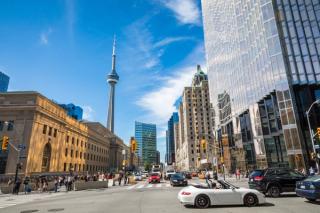
Reflecting on Toronto's Terms of Reference for pedestrian wind comfort
- Post Date
- 13 November 2025
- Read Time
- 3 minutes

Wind is not a force we can ignore; it influences our daily lives and is a vital factor when it comes to achieving welcoming and comfortable outdoor spaces. As communities grow and evolve, approaches to pedestrian comfort and accessibility has become increasingly important in urban planning. The City of Toronto provides one approach of how cities are adapting their planning processes to match their development requests. In June 2022, the City updated its Terms of Reference (ToR) for pedestrian wind, implementing more stringent criteria and altering when wind considerations are addressed within the planning process – now requiring pedestrian wind comfort analyses as part of the Zoning By-Law Amendment (ZBA) application, as well as the Site Plan Approval (SPA) application.
Three years on, I think it’s an appropriate time to reflect on how the ToR has influenced expectations around pedestrian wind comfort in Toronto and the Greater Toronto Area (GTA). In my view, the combination of stricter criteria and the altered timing, has required a resetting of expectations by the City, owners, architects, and consultants.
For instance, by requiring a pedestrian wind comfort analysis as part of the ZBA application, the ToR reinforces the civic duty tied to building form. This is a reasonable shift in approach, especially given that pedestrian wind comfort has been an evolving consideration in Toronto since the 1980s.
With buildings increasing in height and the City adopting more stringent criteria, initial wind studies are generally identifying more safety exceedances than previous analyses. Safety cannot be ignored or put off, as ZBA approval is contingent on developments meeting safety standards within the public realm. For design teams this presents a new challenge, as they are often required to adjust building massing to address concerns appropriately. Previously, these issues were (typically) delayed to SPA and addressed through smaller architectural features with limited impact, as options were restricted by easements, property lines, and the pre-agreed building envelope.
To address these new challenges effectively and efficiently, the following approaches should be considered:
Anticipate potential wind challenges early
Developments taller than 15-storeys have potential to create uncomfortable and unsafe wind conditions, reflecting the ToR criteria and the local wind climate. In addition, projects located on the north or west edges of built-up areas or serving as the first “tall building” in an area, may face pedestrian wind challenges due to full exposure to prevailing winds.
Consider phasing early
Delays between Phase 1 and subsequent phases of the development are inevitable in the current economic climate. The ToR accounts for this possibility, and the City is beginning to require design teams to address phased development impacts through the pedestrian wind analysis.
Engage with a consultant early
Collaborate with a wind consultant early in the project, ideally during the Schematic Phase. Experienced preliminary guidance can help minimize safety and comfort concerns on and around the project. Early guidance also reduces costs in the long term - addressing concerns early is far more efficient than conducting multiple analyses later in the process.
Wind consultants are not the 'bad guys'; we are your partners in achieving safe and comfortable spaces. The goal is not to repeatedly test your building or be the bearer of bad news. By considering the points outlined above early in the process, projects can proceed more smoothly and efficiently, benefitting design teams and the community.
Contact our team to learn how we can support your projects and help create comfortable, community-focused spaces.
Get in touchRecent posts
-

-

-

6 Key Takeaways from the AASB’s Guidance on Disclosing Anticipated Financial Effects
by Emma Elbaum, Elizabeth Lu, Henry Partridge
View post